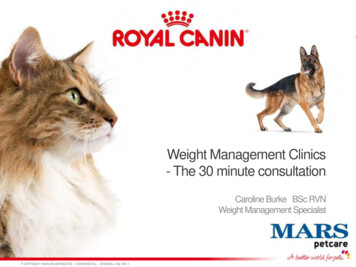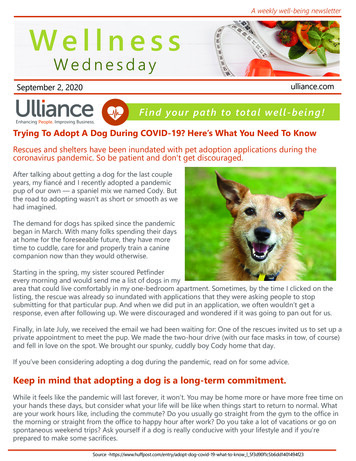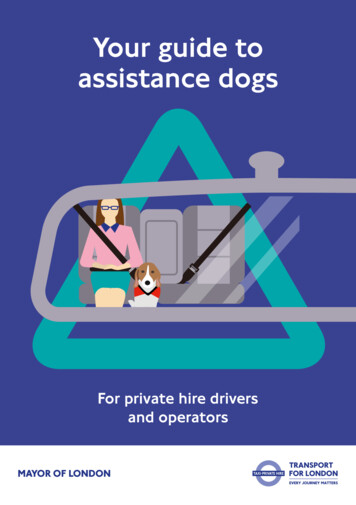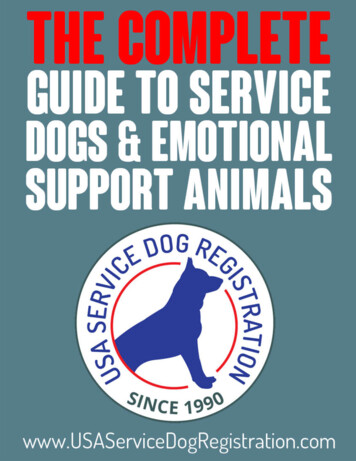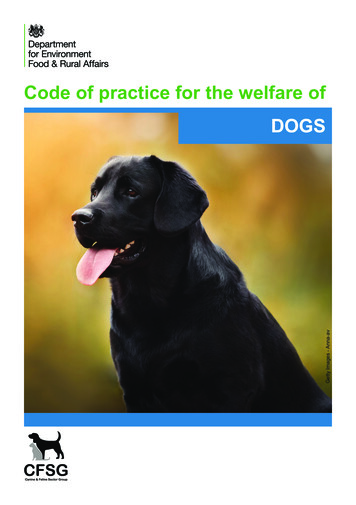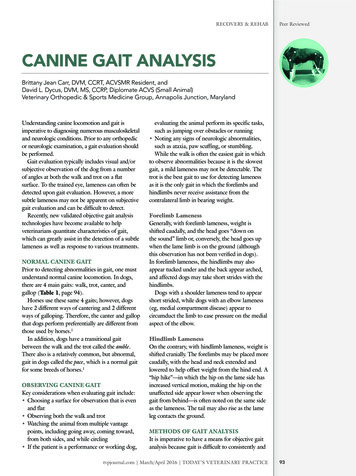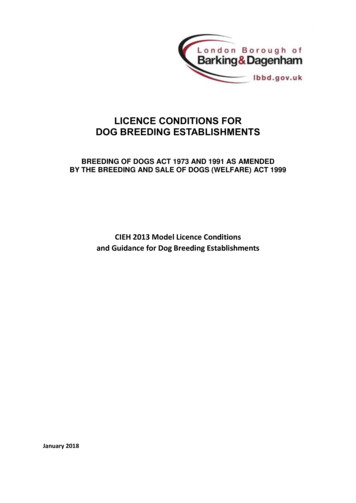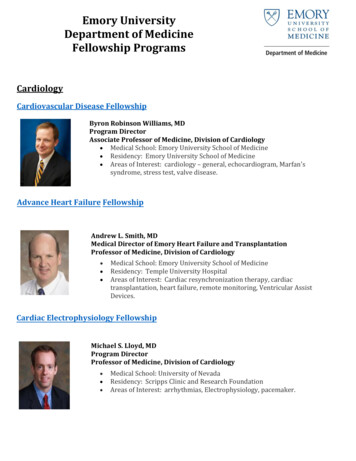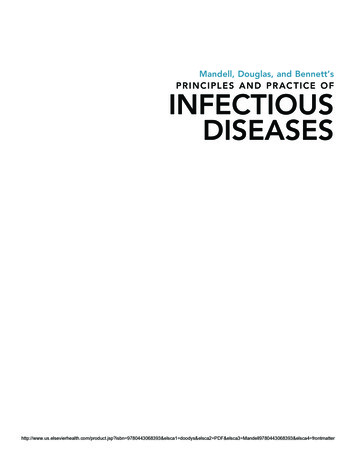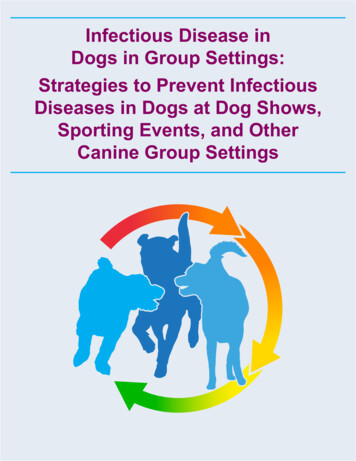
Transcription
Infectious Disease inDogs in Group Settings:Strategies to Prevent InfectiousDiseases in Dogs at Dog Shows,Sporting Events, and OtherCanine Group Settings
ContentsAuthors and Acknowledgments.4Introduction.5Factors that Determine the Outcome of Infectious Disease Exposure.6Transmission: How Infectious Diseases Spread.7Direct Contact Transmission.7Airborne Transmission.8Oral Transmission.8Fomite Transmission.8Vector-borne Transmission.8Principles of Infection Prevention and Control.9Evidence-Based Recommendations to Prevent Infectious Diseases in Dogs at Group Settings.10General Recommendations.10Risk Assessment and the Infectious Disease Control Plan.10Exclusion Criteria For Participation in Group Settings.11Vaccination Recommendations.12Core Vaccines.12Antibody Titers as a Substitute for Vaccination.14Vaccination of Puppies.14Noncore Vaccines.15Insect and Wildlife Control Recommendations.16Vector Control and Vector-Borne Disease atome Insects.19Transmissible External Parasites.19Infectious Disease in Dogs in Group Settings2
Enteric Disease Recommendations.20Environmental Disinfection and Hygiene Recommendations.20Cleaning and Disinfection.20Management of Animal Waste.21Hand Hygiene.22Animal Hygiene.22Management of Fomites.23Additional Exclusionary Considerations.23Facility Design and Traffic Control Recommendations.24Disease Recognition and Response Recommendations.26Conclusion.29Glossary of Terms.30Appendix 1: Infectious Diseases of Concern in Canine Group Settings.32Appendix 2: Factors Determining Outcome of Infectious Disease Exposure.37Appendix 3: Recommended Vaccines for Dogs in Group Settings.38Core Vaccines.38Non-Core Vaccines.38Appendix 4: Summary of Existing Guidelines for Facilities that Temporarily House Groups of Dogs.39Appendix 5: Disinfectants.41Spectrum of Selected Disinfectants.41Properties of Disinfectants Recommendended for Routine Disinfection of EnvironmentalSurfaces and Equipment.42Appendix 6: Surveillance Conditions for use by Canine Group Setting Organizers.43Appendix 7: Checklist for Dog Group Setting Organizers.44Appendix 8: Checklist for Owners/Handlers of Dogs Participating in Group Settings.48References and Resources.51Infectious Disease in Dogs in Group Settings3
Authors and AcknowledgmentsThis document was prepared and based on work by:Jason W. Stull, VMD, PhD, DACVPM1Robert G. Sherding DVM, DACVIM1Jeanette O’Quin, DVM, MPH1Michelle D. Evason, DVM, DACVIM3Jennifer I. Kasten, DVM1Armando E. Hoet, DVM, PhD, DACVPM1,2Mary Jo Burkhard DVM, PhD1J.S. Weese, DVM, DVSc, DACVIM4The Ohio State University, College of Veterinary Medicine2The Ohio State University, College of Public Health3Michelle Evason Veterinary Internal Medicine & Nutrition Consulting4University of Guelph, Ontario Veterinary College1This project was supported by the AKC Canine HealthFoundation and the Orthopedic Foundation for Animals. Thecontents of this work are solely the responsibility of the authorsand do not necessarily represent the views of the Foundations.September 2016Infectious Disease in Dogs in Group Settings4
IntroductionThe aim of this document is to serve as a resourcefor the recognition of risk, prevention and control ofcanine infectious diseases. Disease causing agents(pathogens) include parasites, viruses, bacteria,fungi, and protozoa. Hundreds of these infectiouspathogens have the potential to be transmittedbetween dogs; however, only a subset of thesecommonly causes problems. Some are of particularconcern in settings that bring groups of dogstogether. Additionally, some of these pathogenscan be spread between dogs and people (termed“zoonotic”), causing illness in people addingadditional concerns.Canine “get-togethers” and group events areextremely important social interactions for dogsand their owners. These events are very popularand fun and include a wide variety of activities suchas dog shows, off-leash dog parks, canine athleticevents and dog daycare. Thousands of dogs andpeople may attend a single event occurring overseveral days.Bringing dogs together increases the risk ofexposure to many infectious diseases (Appendix1). Infectious agents introduced into these settingscan lead to disease outbreaks that can potentiallyspread into the dog community with devastatingconsequences. This occurred during the rapidspread of canine parvovirus in the late 1970’s, andmore recently with the H3N2 canine influenzavirus (canine flu). Infectious disease awareness,prevention, and control strategies can decreasethese risks and help protect the health of dogs andtheir owners.Anton Gvozdikov/ShutterstockInfectious Disease in Dogs in Group SettingsThe AKC Canine Health Foundation and theOrthopedic Foundation for Animals funded apanel of canine infectious disease experts todevelop scientifically-sound, evidence-basedguidelines intended for people who organize,manage, staff, or participate in a variety ofdog group settings, including: Dog shows (e.g. conformation, obedience,agility, rally) Canine sporting and performance events (e.g.field trials, herding, lure coursing, hunt test,dock jumping, flyball, weight pulls, earth dogtest, tracking, sled racing) Off-leash dog parks Training and socialization classes (e.g. puppyclasses) Dog daycare facilities Boarding facilities and other kennels that grouphouse owned dogs Community events involving many dogs thatmay have close contact (e.g. festivals, expos,parades, fund raising eventsThe recommendations in this document arebased on established scientific principles ofinfectious disease prevention combined with twoadditional sources of information specific to dogs:first, a comprehensive review of the publishedscientific literature; and second, input from keyopinion leaders, stakeholders, and experiencedevent participants through a national survey andtargeted focus group discussions. The literaturereview included over 400 articles in peer-reviewedjournals as well as major veterinary textbooks oncanine infectious disease. Key websites devotedto canine parasites and infectious diseases werealso reviewed. When setting-specific publicationswere lacking, recommendations were based onthe collective expertise of the authors.This document was developed with a variety ofgroup settings in mind; not all recommendationswill apply to every group setting. Events andsettings vary in the types and number of dogsinvolved, the amount of contact between dogs,and the ease and feasibility of implementingrecommendations.5
Because risk, need, and practicality vary betweensettings, this document is meant to provideguidance for those responsible for infectiousdisease prevention. It will be at the discretion offacility managers and event officials to decidewhen and how these recommendations areimplemented and to what extent compliance isenforced.In addition to this document, the authors havedeveloped the following resources: A peer-reviewed journal article. Thisfreely available article aimed at veterinaryprofessionals provides an in-depth backgroundon this topic, specific disease risks, andsupporting evidence for the recommendations. A risk calculator. This 10-minute on-lineconfidential tool calculates the user’s specificdog infectious disease risk at canine groupsettings, providing advice for group eventparticipants and event organizers. Several fact sheets addressing importantpathogens for canine group settings.The above items along with additional resourceson the topic can be found at the followingwebsites: Infectious Disease in Dogs in Group Settings Worms and Germs BlogSeveral existing resources specifically addressinfection control in small animal veterinary clinicsettings and should be reviewed for additionalguidance as appropriate (Stull & Weese 2015,Canadian Committee on Antibiotic ResistanceInfection Prevention and Control Best Practicesfor Small Animal Veterinary Clinics 2008, NASPHVVeterinary Standard Precautions Compendium2015).We hope this document and accompanyingresources are helpful to all involved in dog groupsettings and will help to protect the health of dogsand people.Factors that Determine the Outcomeof Infectious Disease ExposureWhether or not a dog will develop diseasefollowing exposure to an infectious agent isdependent on many factors. Some of theseinclude:1. Type of infection or infecting agent (pathogen)2. How long the dog is exposed or in contact withthe infectious agent3. The amount (dose) of pathogen that the dogencounters4. How the infection is transmitted (passed to thedog), e.g. feces ingestion, cough or sneeze5. The dog’s immune status or vulnerability of thedog to the agent (Appendix 2).Some infectious agents spread quickly and easily,while others may require a large dose (amount)or very close contact with a contagious dog inorder to cause disease. One of the more importantcharacteristics of the infectious agent is how longit can live in the environment.Infectious Disease in Dogs in Group SettingsSome pathogens will be killed quickly (e.g.minutes to hours) due to drying or temperaturechanges in the environment, while others cansurvive for weeks or months, and may evensurviving freezing temperatures and somedisinfectants. Understanding the different diseasecausing agents is essential to making plans thathelp reduce risk and protect dogs and people inthese group settings.Another important factor in the development andseverity of disease is the dog’s general healthand immune status. In some cases vaccinationcan lead to immunity that protects the dog frominfection or reduces the severity of illness. Themain reason that younger age is a risk for diseaseis because younger animals may not yet havedeveloped immunity to common infectious agents.Injury, illness, inadequate nutrition, and stress,even the stress associated with travelling, can allreduce the body’s ability to fight infection, makinga dog more prone to develop disease if exposed.6
Transmission: How Infectious Diseases SpreadInfectious agents can be brought to and spreadthroughout canine group setting in many ways.Some of these include:1. Infectious agents can live on or in dogs,people, other domestic animals, and wildlife.2. Infectious agents can be in food, water, waste,feces, and the environment.3. Vehicles and equipment can bring and spreadinfectious agents.4. Many types of insects, such as mosquitos, ticksand fleas, can carry and transmit infectiousagents through their bite.Infected dogs are most contagious to other dogswhen they are showing signs of disease; however,they may also be contagious before becomingill and for a period of time after recovery. Someinfections are contagious without ever causingobvious signs of disease. Given that healthyappearing animals can spread infectious agents, itis reasonable to assume that any dog that entersa group setting is potentially infectious and able tospread disease to other dogs.Depending on the infectious agent, dogs mayspread it through respiratory droplets (e.g.cough, sneeze, or nose-to-nose touching), saliva,feces, vomit, urine, blood, wound seepage,and reproductive fluids (e.g. semen or vaginaldischarge). Some infectious agents require closecontact between animals for transmission to occur,while others can contaminate soil, water, cages,floors, and other objects (fomites) including toys,grooming equipment, leashes, food or waterbowls, transmitting the infection indirectly. Stillothers can be transmitted through or on insectsand ticks. Many infectious agents can surviveoutside of the animal for extended periods oftime; therefore, preventive measures alwaysneed to take environmental contamination intoconsideration.and interrupt routes of transmission are keyaspects of prevention against most infectiousdiseases that affect dogs. The five major routes oftransmission for infectious agents between dogsare direct contact, aerosol, oral, vector-borne,and fomite. Infectious agents utilize one or moreof these routes to spread disease to new dogs.Measures to prevent disease transmission in doggroup settings must take all of these routes intoconsideration.Direct Contact TransmissionDirect contact transmission occurs when aninfectious agent is transferred directly from onedog to another. This can occur through touching(e.g. nose to nose, or nose to bottom), licking,biting and mating. Infectious agents may alsospread directly through tiny droplets of spray(aerosolization) produced through barking,sneezing and coughing. These droplets caneasily travel several feet (1 meter) before landingon surfaces. Therefore increasing the distancebetween animal housing to at least 4 feet (1meter) will help reduce droplet transmission.Dogs that are sick (e.g. coughing, sneezing) canspray droplets much greater distances (e.g. 18ft, 6 meters). To prevent transmission by directcontact, dogs known or suspected to have aninfectious disease should always be isolated (keepseparated) from healthy dogs and removed fromthe event premises as soon as possible.To cause disease, every infectious agent hasto contact a susceptible dog; typically throughingestion (eating or biting and swallowing),inhalation (breathing in), or penetration (e.g. cutsor bites) through the mucous membranes or skin.Therefore, measures to prevent exposureInfectious Disease in Dogs in Group Settings7
Airborne TransmissionFomite TransmissionAirborne transmission occurs when infectiousagents are suspended in the air. While trueairborne pathogens are rare, they are able totravel great distances (greater than 4 feet/1meter) and remain suspended in the air for longperiods of time before they are inhaled or settleon surfaces. Some pathogens can becomeairborne through barking, coughing or sneezingwhile others may become airborne following theevaporation of contaminated body fluids such asurine. They can be suspended or re-suspended inthe air through mechanical actions such as wind,hair dryers, vacuums, fans, spraying water, andthe shaking out of bedding or towels. Airborneinfections can spread quickly through a groupof dogs that share the same airspace. Goodventilation in indoor facilities will provide at least10 to 20 air exchanges per hour which reducesthe risk of airborne transmission. Overcrowding ofdogs should be avoided, and sick animals shouldbe isolated from other susceptible dogs so they donot share the same air space.Fomites are inanimate (non-living) objects andsurfaces that are contaminated with infectiousagents. They can facilitate the spread of infectiousagents throughout a facility and even into thecommunity; being of greatest concern when theinfectious agent can survive outside of the animalfor an extended period of time. Common fomitesinclude items such as dog toys, leashes, bowls,grooming equipment, cages and bedding, butalso human use items such as clothing, shoes,markers, pens, backpacks and other bags.Avoid sharing of items between dogs. Usingdisposable items and disinfecting non-disposableitems between uses can help reduce fomitetransmission.Vector-Borne TransmissionOral TransmissionOral transmission occurs when infectious agentsare ingested. This often occurs through eating ordrinking contaminated food, treats, or water, andoral contact with contaminated environmentalsurfaces such as the ground or floor (e.g. sniffing,eating or licking directly off the ground). It can alsooccur through mouth contact with contaminatedanimals or objects such as toys (e.g. ropes, balls),and body contact with contaminated surfaces oritems such as brushes, followed by self-grooming.Ensuring a safe food and water supply, and closeattention to cleaning and disinfection, will reducethe chances of oral transmission.Infectious Disease in Dogs in Group SettingsVectors are animals and insects that act as“intermediaries” and transmit infectious agentsfrom an infected animal to a susceptible dog.Infectious agents can be transmitted by vectorseither mechanically or biologically. Mechanicaltransmission occurs when the infectious agent issimply transported from dog-to-dog by a vectorsuch as a human or a fly. Biological transmissionoccurs when the infectious agent is taken up bythe vector, usually through a blood meal froman infected animal. The infectious organismlives within the vector until it is transmitted to asusceptible dog. Fleas, ticks and mosquitoes arecommon biological vectors of disease. Effectiveflea, tick, and mosquito preventive measures areimportant ways of reducing vector-borne diseaserisk.8
Principles of Infection Prevention and ControlInfection prevention and control strategies aredesigned to protect dogs, personnel (owners,handlers, trainers, staff), and the community.These strategies require that everyone involvedplay an active role and consider actions thatprotect animals and people from the spread ofinfectious diseases. Not all infectious diseases canbe prevented, but many can. Infection preventionand control measures can be broadly divided intotwo main categories: measures to decrease dogexposure to infectious agents and measures todecrease dog vulnerability to infectious agents.Eliminating or decreasing Exposure is one ofthe most important aspects of infection control.If a dog is not exposed to a high enough dose ofan infectious agent, then disease simply cannotoccur. There are many ways to minimize exposurein a dog group setting, including: Ensuring that contagious dogs do not enter agroup setting. Minimizing direct interaction (contact) with otherdogs (when feasible). Avoiding contact with environments and objectsthat might be contaminated with infectiousagents (e.g. not sharing equipment betweendogs without first cleaning and disinfecting). Controlling disease vectors (insects and wildlife)or choosing locations/times of the year forevents where/when disease vectors are lesscommon. Encouraging hand hygiene (washing hands withsoap and water or using an alcohol-based handsanitizer) by all people, especially betweentouching different dogs not from the sameowner. Using effective cleaning and disinfectionpractices. Early identification and isolation of potentiallyinfectious dogs from other dogs in the group.Infectious Disease in Dogs in Group SettingsThe Vulnerability of a dog to an infectious agentalso plays an important role in determining ifinfection will occur. In general, dogs with goodoverall health and nutritional status are lesssusceptible to infections. Due to a still developingimmune system and incomplete vaccination,puppies are generally more susceptible toinfectious disease than adult dogs. In addition,dogs with existing health conditions (e.g. diabetes,cancer) are generally more susceptible toinfectious disease than other dogs. In all dogs,a number of measures can be taken to minimizevulnerability of a dog in a group setting. Following veterinarian-recommended preventivecare:Recommended veterinary wellness care,including vaccinations and parasite controlmeasures, are important aspects of reducingvulnerability to infectious agents. All dogsshould receive the appropriate corevaccinations (Appendix 3) and parasitepreventatives at the frequency recommendedfor dogs in group settings where they live, traveland compete. Decreasing stress in dogs:Just as with people, stress can reduce theability to fight off an infection. Efforts shouldbe made to manage animal stress, which cancommonly be expected with travel, changes inroutine, confinement, diet changes, crowdedenvironments, and being around unfamiliarplaces, people, and animals.9
Evidence-Based Recommendations to PreventInfectious Diseases in Dogs at Group SettingsThe authors developed 64 recommendationsaimed at preventing infectious disease in dogsin group settings based on careful review of theexisting literature, input from a focus group ofstakeholders and key opinion leaders, and asurvey of canine group settings participants. Thelevel of evidence for each recommendation isprovided in an accompanying published article onthe topic (Stull, 2016). The recommendations canbe grouped into nine categories:1. General recommendations2. Vaccination3. Insect and wildlife control4. Vector (e.g. tick, fleas) control and vector-bornedisease prevention5. Enteric (intestinal tract) disease preventionEach category is discussed below, emphasizingpractical steps that can be taken at the individualdog level, dog group level, and environment level(checklists summarize these recommendations forthe dog owner and setting organizer; Appendices7 and 8). Addressing all three levels is important inreducing infectious disease in dog group settings.Recommendations are bolded in each section(a summary sheet with all recommendations isavailable here).It is important to understand that not allrecommendations are applicable or feasiblefor every dog group setting. Dog owners andevent organizers are encouraged to use this andaccompanying resources to identify key infectiousdisease risks for their setting(s) and appropriaterecommendations to reduce these risks.6. Environmental disinfection and hygiene7. Additional exclusionary measures8. Facility design and traffic control9. Disease recognition and responseGeneral RecommendationsRisk Assessment and the Infectious DiseaseControl PlanIt is easiest to prevent infections if the risks areknown in advance. Some infectious agents arecommonplace throughout certain environmentsand may be naturally present at certain groupsettings, while others present a risk only ifintroduced by an infected dog. The risks will varybased on the nature and location of the groupsetting, the activities that are expected to occur, thefacilities and housing, the duration of the event, thetime of year, and the individual dogs participating.For these reasons and overall awareness, a riskassessment for each specific group setting orevent should be performed and strategies putin place to reduce infection before it occurs.An on-line risk calculator is available to helpparticipants and organizers proactively perform arisk assessment for their dogs and event.Infectious Disease in Dogs in Group SettingsIdentifying disease risks allows for development ofvenue-specific control and prevention strategies,protocols, and management practices. Examplesinclude participation requirements, hand washing/sanitizing stations, isolation areas in casedogs become sick and cannot be immediatelyremoved from the premises, and environmentalmanagement. All of these specific measures aimedat preventing the entry and spread of infectiousdiseases at a particular group setting should bedeveloped and together form an infectious diseaseplan. The plan should also include instructionsfor how a potentially contagious dog should behandled. These include recognition of infecteddogs and dogs to whom they may have passedthe infection, isolation, medical evaluation, andenvironmental disinfection based on the suspectedor confirmed infectious agent.10
For each group setting, a written infectionprevention and control plan should be inplace and include strategies aimed at theindividual dog, the population of dogs, and theenvironment.Each facility, event, or group setting is unique, anddetailed knowledge of specific infectious agentsis necessary to accomplish the tasks describedabove. For these reasons it is recommended thatorganizers involve other relevant stakeholders,including a veterinarian, when performing a riskassessment, developing an infection control plan,or revising an existing infection control plan.Every group setting should have access (onsite or off-site) to a veterinarian who can assistwith developing and implementing infectiousdisease prevention guidelines specific for thatgroup event or setting.It is recognized that developing an effectiveinfection control plan takes time and resources. Itis recommended that, where appropriate, relevantparent organizations and overseeing bodies assistin preparing model or draft plans for a given eventtype or setting (e.g. largely in-door dog show,outdoor agility event). In such a case, individualgroups can review their particular risks as statedabove and personalize a draft plan to addressthese risks and the particulars of the venue.Relevant disease management protocols shouldbe incorporated into the rules and regulationsof the setting, communicated to all participantsprior to the event, and prominently displayed withsignage at the facility or event. To maximizecompliance, requirements for involvement ingroup events, including pertinent jurisdictionalregulations, as well as the rationale for suchrequirements should be clearly explained toparticipants prior to the event and enforceduniformly during the event.bite prevention, recognition of a sick dog, effectiveanimal handling and restraint techniques andcommunication techniques to interact withowners. In summary, successful implementationof an infection control plan requires education,awareness, and compliance on the part ofeveryone involved.Best practices for veterinary infectious diseasecontrol are often in-line with other areas, such asanimal welfare. Dogs that are comfortable withreduced stress will be at a lower risk for infectiousdisease transmission than dogs in more stressfulsituations. Canine welfare guidelines have beenpreviously developed and may be particularlyuseful for guiding facilities that temporarily housegroups of dogs (e.g. dog daycare, boarding;Appendix 4).Exclusion Criteria for Participation in GroupSettingsEvent officials and facility managers areencouraged to establish policies that prohibitentry and participation of dogs showing signs ofinfectious disease. Only dogs without evidenceof infectious disease should participate ingroup settings. Dogs that are suspectedto be infectious or with signs of infectiousdisease (e.g. fever, cough, discharge fromthe eyes and nose, vomiting, diarrhea,
Training and socialization classes (e.g. puppy classes) Dog daycare facilities Boarding facilities and other kennels that group house owned dogs Community events involving many dogs that may have close contact (e.g. festivals, expos, parades, fund raising events The recommendations in this document are
